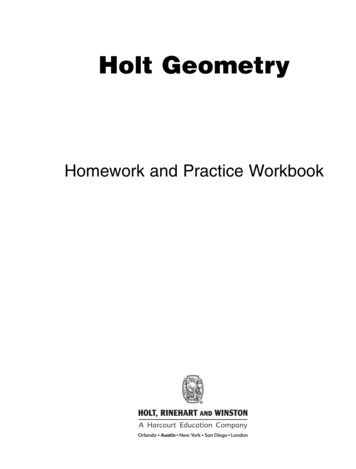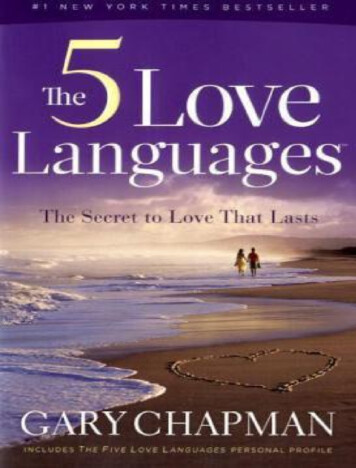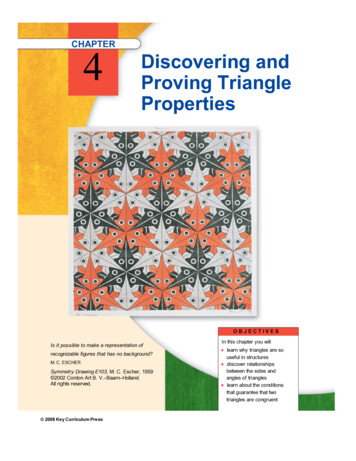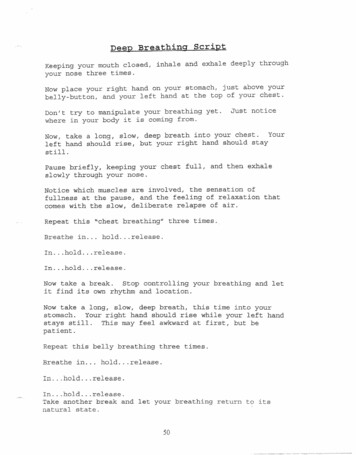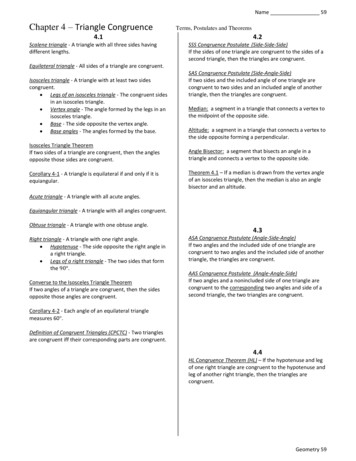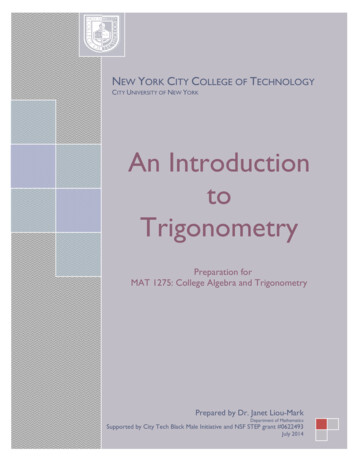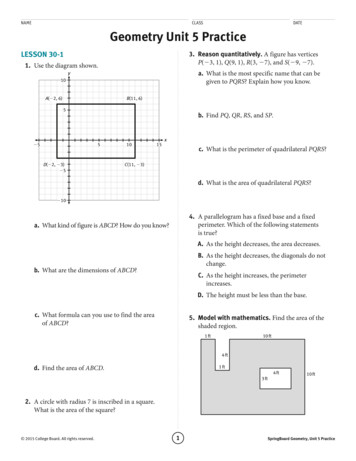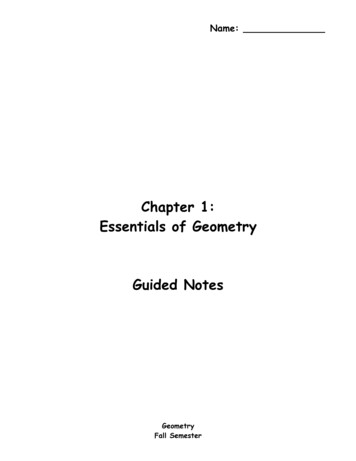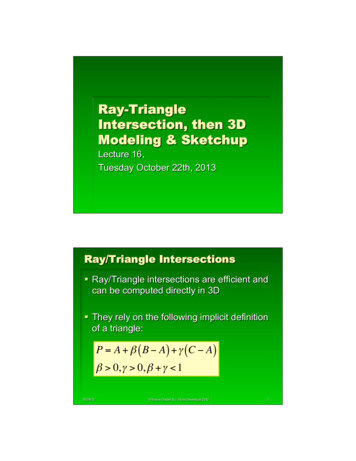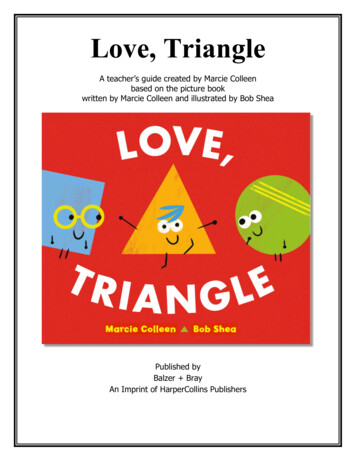
Transcription
Love, TriangleA teacher’s guide created by Marcie Colleenbased on the picture bookwritten by Marcie Colleen and illustrated by Bob SheaPublished byBalzer BrayAn Imprint of HarperCollins Publishers
Marcie ColleenAuthor, Love, TriangleIn previous chapters Marcie Colleen has been a teacher,an actress, and a nanny, but now she spends her dayswriting children’s books! She is the author of The SuperHappy Party Bears chapter book series withMacmillan/Imprint. Love, Triangle is her debut picturebook. She lives with her husband and their mischievoussock monkey in San Diego, California. Visit her atwww.thisismarciecolleen.com.Bob SheaIllustrator, Love, TriangleBob Shea has written and illustrated over a dozenpicture books, including the popular Dinosaur vs. andBallet Cat series, I’m a Shark, and Oh, Daddy! Hischaracters and animations have appeared on Nick Jr.,Disney Junior, and PBS Kids. Bob spends his dayswriting and drawing. Visit him at www.bobshea.com.This guide was created by Marcie Colleen, a former teacher with a BA in English Education from OswegoState and a MA in Educational Theater from NYU. In addition to creating curriculum guides for children’sbooks, Marcie can often be found writing books of her own at home in San Diego, California. Visit her atwww.thisismarciecolleen.com.1
How to Use This GuideThis classroom guide for Love, Triangle is designed for students in preschool throughthird grade. Teachers are welcome to adapt each activity to meet the needs andabilities of their own students.The guide offers activities to help teachers integrate Love, Triangle into Englishlanguage arts (ELA), mathematics, science, and social studies curricula. Art and dramaare used as a teaching tool throughout the guide.All activities were created in conjunction with relevant content standards in ELA, math,science, social studies, art, and drama.************Title: Love, TriangleAuthor: Marcie ColleenIllustrator: Bob SheaAges: 4- 8/Grades: P- 3Publisher: Balzer Bray (October 3, 2017)ISBN: 978- 0062410849Brief synopsis:Ever since they were a dot and a speck, Circle and Square have been best friends. Thensomeone new comes along: a cool, exciting Triangle. And three starts to feel like acrowd With their friendship bent out of shape, can they put it back together again?Copyright InformationGuide content copyright 2017 by Marcie Colleen. Available free of charge foreducational use only;; may not be published or sold without express written permission.2
Table of ContentsEnglish Language Arts (ELA)Reading Comprehension4Writing Activities6Who is Circle? Who is Square? Character StudyLove, Triangle the sequelTriangle’s Point of View78Speaking and Listening ActivitiesChoral ReadingMimeDramaLanguage ActivitiesVocab DetectivesPun Fun9MathThe Geometry of ArtGeometric Collage“Shape Up” Field Trip10111213ScienceThe Scientific MethodBuild a Slingshot ChallengeSocial StudiesFinding Commonalities/Uniqueness with our FriendsTeamwork Trio3
English Language ArtsReading ComprehensionBefore reading Love, Triangle,Help students identify the basic parts of a picture book: front cover, back cover, titlepage, spine, end papers, and jacket flap.The Front Cover Describe the cover illustration.o Who do you see?o Use one word to describe each character. Explain your answer usingevidence from the illustration.In groups of three, mimic what the shapes are doing.o How does this make you feel?o How do you think each shape is feeling? What do you think each shape isthinking?The Back Cover Describe the back- cover illustration.o Who do you see?o Use one word to describe each character. Explain your answer usingevidence from the illustration.In groups of three, mimic what the shapes are doing.o How does this makeyou feel?o How do you think eachshape is feeling? Whatdo you think eachshape is thinking?o Compare this illustration to the illustration on the front cover. What is thesame? What is different?4
The Jacket Flap Read the text aloud. Choose three or more key words from this jacket flap. Using the text on the jacket flap, describe once again what is happening in thecover and back cover illustrations.Now read or listen to the book.Help students summarize in their own words what the book was about.Help students define the events in terms of a plot arc by using the following chart.BeginningM iddleCircle and Square are the Triangle shows up.best of friends.Describe:Introduce character:EndResolution. How are thingssolved?The ending The Climax, wheneverythingchanges BONUS: Using the basic plot structure above, students can create an originalstory about Circle, Square, and Triangle. Students can work individually, witha partner, or as a class. Art center Provide a variety of art materials including crayons, pencils,markers, paint, scissors, colored paper, old magazines, and glue for studentsto illustrate the scenes in their stories. Drama center Provide puppets, costumes, and props so students canrecreate their new stories.Let’s talk about the people who created Love, Triangle. Who is the author?5
Who is the illustrator? What kind of work did each person do to make the book?Now, let’s look closely at the illustrations. Check out some of the following details that Bob Shea includes in theillustrations. Find:o A bunny dollo A skateboardo An already- eaten piece of pizzao A square birdo A hotdogo A mountain goato A screwdriverWriting ActivitiesWho is Circle? Who is Square? Character StudyCircle and Square have been the best of friends since they were a “dot and a speck.”But who are these characters?How a character acts can tell readers a lot about who the character is.Read Love, Triangle. Scene by scene, record your thoughts regarding each character, ina chart like the one below.Tex tW hat Circle does.W hat Square does.How w ould you describeCircle?How w ould you describeSquare?Example: “Want to share my Square offers to share hisSquare: generous, kind.grilled cheese?” “No thank you. grilled cheese with Circle.Circle: distracted, wantingI am suddenly craving pizza.” Circle is distracted by Triangle. something different, curious.6
Love, Triangle: the sequelAt the end of Love, Triangle, the three friends are playing together when a newcharacter walks by. What do you think will happen? Will Circle, Square, and Triangleplay nicely together? Or will each compete to become best friends with Heart? Becreative and create a sequel to Love, Triangle.Triangle’s Point of ViewEither as a class or individually, explore Love, Triangle from the pointof view of Triangle.Advanced classes will be able to rewrite Love, Triangle from his pointof view. However, if the class is less- advanced, simply have themcreate captions and thought- bubbles for him. The thought- bubblesand captions can be written on Post- It Notes and placed on the pagesof the book.Speaking and Listening ActivitiesPicture books are written to be read aloud. Here are some other ways to bring Love,Triangle to life in the classroom and have fun with speaking and listening skills!Choral ReadingDivide the class into groups of three. One group will take the role of Circle.Another group will take the role of Square. The third group will take the role ofTriangle.Create a script.Read the script aloud together.Emphasize memorization, as well as good vocal expression.MimeWhile the teacher reads the book aloud, the students can act out the story.Emphasize body motion and facial expressions, as well as listening skills.Drama Create a TV commercial to encourage people to read Love, Triangle.7
In small groups, act out Love, Triangleas an opera, a western, a “breakingnews” story, a thriller, etc. The rest ofthe class should guess what the “style”is.Language ActivitiesVocab DetectivesLove, Triangle has some new and challenging vocabulary.Words like “admired” and “apex” may be unknown to some young readers.Re- read Love, Triangle aloud and ask students to listen carefully for words they do notknow. As soon as they come across an unknown word they should raise their hand. Repeat the phrase using the unknown word. What might it mean, based oncontext? Look up the word in the dictionary. (Depending on the level of your students, astudent volunteer can do this or the teacher can.) Read the definition. Come up with a way to remember what the word means. Using Total PhysicalResponse, students can create an action that symbolizes the word and helpsthem remember it. Re- read the story and when you come to a vocabulary word, have the studentsfill in the meaning in how they choose to remember it.Create a list of vocabulary words and hang it on the wall to revisit again and again.Pun FunA pun is a type of figurative language that uses words that have two or more meaningsto create an alternate, sometimes humorous, interpretation. Colleen uses punsthroughout Love, Triangle. The result is a funny, math- pun- filled story.Example:Circle and Square’s friendship had a shape of its own.The double meaning word in this example is shape.It means, the state of how something is. (My math grade is in bad shape.)It also means, the outline of an object or area. (My pool is the shape of a circle.)8
Read through Love, Triangle, and for each pun, determine the word or words thatcreate the pun. Then, explain the two meanings.MathThe Geometry of ArtDrawings are simple shapes put together to create an object.Have students find circles, squares, ovals, rectangles, and triangleswithin the illustrations of Love, Triangle.How many circles, squares, or triangles can they find?As a class, create a table to record how many circles, squares, and triangles appear ineach spread of Love, Triangle.How manycircles?Ex. Front Cover201How manytriangles?2Title PageSpreadHow manysquares?“Ever since they werea dot and a speck”page“A wedge camebetween them” spreadAdditional Challenge: Now compare the numbers of circles, squares, and triangles oneach spread, using these symbols: (is greater than) (is equal to) (is less than)Example: On the front cover, the number of circles is squares triangles.Geometric CollageProvide students with various pieces of construction paper shapes: circles, squares,rectangles, ovals, hearts, triangles, etc.9
Challenge each student to use the shapes to create a picture. For example, maybe arectangle turns into a building with a triangle pine tree nearby and a circle sun in thesky.Try to move students towards creating objects, as Shea does throughout Love,Triangle, instead of abstract works.Encourage adding lines with markers to enhance objects and add detail.“Shape Up” Field TripDivide the students into three teams: Circles, Squares, and Triangles.Lead them on a field trip to the library, playground, or through the school hallways.As a group, each team must look for their assigned shape in various objects seen onthe trip.If possible, each team should be given a digital camera to record their findings.Students should also take notes and jot down what object they found and where theyfound it.At the end of the field trip, students will return to the classroom and try to draw orcreate a photo collage of the items that their team found for display in the classroom.Optional: For further technological experience, teams can use the computer and ascanner to create a multimedia presentation of their findings to present to the class.ScienceThe Scientific MethodWhen Triangle tragicallybecomes unraveled, Squareturns to research and scienceto solve the problem.Chances are he uses theScientific Method.The Scientific Method is an eight- step series that engineers, scientists and inventors useto problem solve.Step 1: Ask a Question10
Step 2: Do ResearchStep 3: Guess an Answer (also called a Hypothesis)Step 4: Test Your Guess/HypothesisStep 5: Did it Work? Could it Be Better? Try AgainStep 6: Draw a ConclusionStep 7: Write a Written Report of Your ResultsStep 8: RetestAfter introducing the eight steps to the class, lead them through a discussion. Describe how these eight steps help with problem solving. What do you think would happen if you skipped a step? Why do you think step 8 is important? Can you find evidence that Square used some of these steps in Love, Triangle?Use textual examples. Create an eight- page Scientific Notebook. Each page will include a separate stepin the process. Imagine you are Square and fill each page with your notes,drawings, and ideas about how to save Triangle. Refer to Love ,Triangle forideas, as well as your own creative imagination.Build a Slingshot ChallengeThis challenge allows students to test out theScientific Method for themselves as theyproblem solve a way to build a slingshot thatreally works! Of course, a little imagination isgoing to go a long way here, too! Explain to students that they will beworking in groups of 2- 3 to create a slingshot. Provide the students with several craft items (rulers, paper, cardboard tubing,empty boxes, tape, glue, etc.) Check the recycling for other ideas of materials. Each group’s slingshot must:o Really work.o Be a construction, not merely one material. The groups must create an eight- page Scientific Notebook for their slingshot andcarefully document their use of the Scientific Method throughout the process ofbuilding their slingshot.Once all slingshots have been built, test them out one by one as a class. Did theywork? Do they need to retest? If they didn’t work, head back to the drawing board likea real inventor.11
Offer up awards to increase the competition.oooooFarthest- Throwing SlingshotMost Attractive SlingshotMost Materials SlingshotLeast Materials SlingshotSilliest SlingshotSocial StudiesFinding Commonalities/Uniqueness with our FriendsCircle and Square are alike in some ways. But they aredifferent in other ways.Finding what students have in common with otherpeople is a good way to start a meaningfulrelationship.Here is a way to learn what students have in commonwith other classmates, while also celebrating what makes each of them unique.Materials: A pen and two pieces of paper. This activity can be done class or in pairs. On one sheet of paper, students will have ten minutes to come up with a list ofthings in common. Completely obvious answers such as “we both have hair” or“we are both in class” are not allowed! After ten minutes, switch to the other paper. They now have ten minutes tocome up with a list of things that are unique to only one person. Share both lists with the class when finished.EXTENSION ACTIVITIES:Pretending they are talk show hosts, students can introduce a classmate to the rest ofthe class.Using Marcie Colleen and Bob Shea’s bios on the back- jacket flap of Love, Triangle,have students write a paragraph about a member of their class.Design a mural, using bulletin board paper, as a tribute to the class’s commonalitiesand uniqueness to display in the school hallways.12
Teamwork TrioCircle and Square struggle to compete to be best friends with Triangle but learn that ifthey only work as a team, they gain a new friend without losing each other.Games can help students develop motor skills, good reflexes, hand- eye coordination,problem solving and language skills. However, competition can cause anxiety and makesome kids feel left out.Cooperative games help promote collaborative skills and teach sportsmanship as kidsplay by helping each other. These games focus on fun and teamwork rather thanwinning.Cooperative HoopsThe game cooperative hoops is a twist on the game "musical chairs." Instead ofhaving each player compete for themselves and exclude others to win as in"musical chairs," this version makes winning about cooperation.Scatter hula hoops around the play area.Play music and have the kids move around the hoops but not step inside them.While the music is playing, the kids must not stop moving, but when it stops,they must have at least one foot inside a hula hoop and not touch the groundoutside the hoop.If any child is not in a hoop when the music stops, they must sit out. On eachrotation, remove a ring so that the kids have to share hula hoops.When the game is down to two hoops, the winners are the kids who got themost people inside one hoop. This game teaches kids to cooperate and helpeach other to win.Continuum13
This cooperative game also lets even the shyest kids break the ice and get toknow one another.Divide the kids into groups of six to ten people.Pick a theme and have the kids arrange themselves in the correct order to createa continuum.This could be favorite colors arranged in the order of the rainbow, birth monthfrom first to last or dark color shirts to lightest. No team loses in this game, butyou can applaud the team that got into the right order the fastest.Keep it UpIn this game, divide the kids into two teams across a net or line.As in volleyball, they must pass a balloon or ball back and forth without letting ittouch the ground. However, the rule is that a different team member must hitthe ball or balloon to the opposite team each time. Other team members canhelp their team players by passing to them.14
Love, Triangle ! Ateacher'sguidecreatedbyMarcieColleen ! basedonthepicturebook ! hea!!!! Published!by!!
